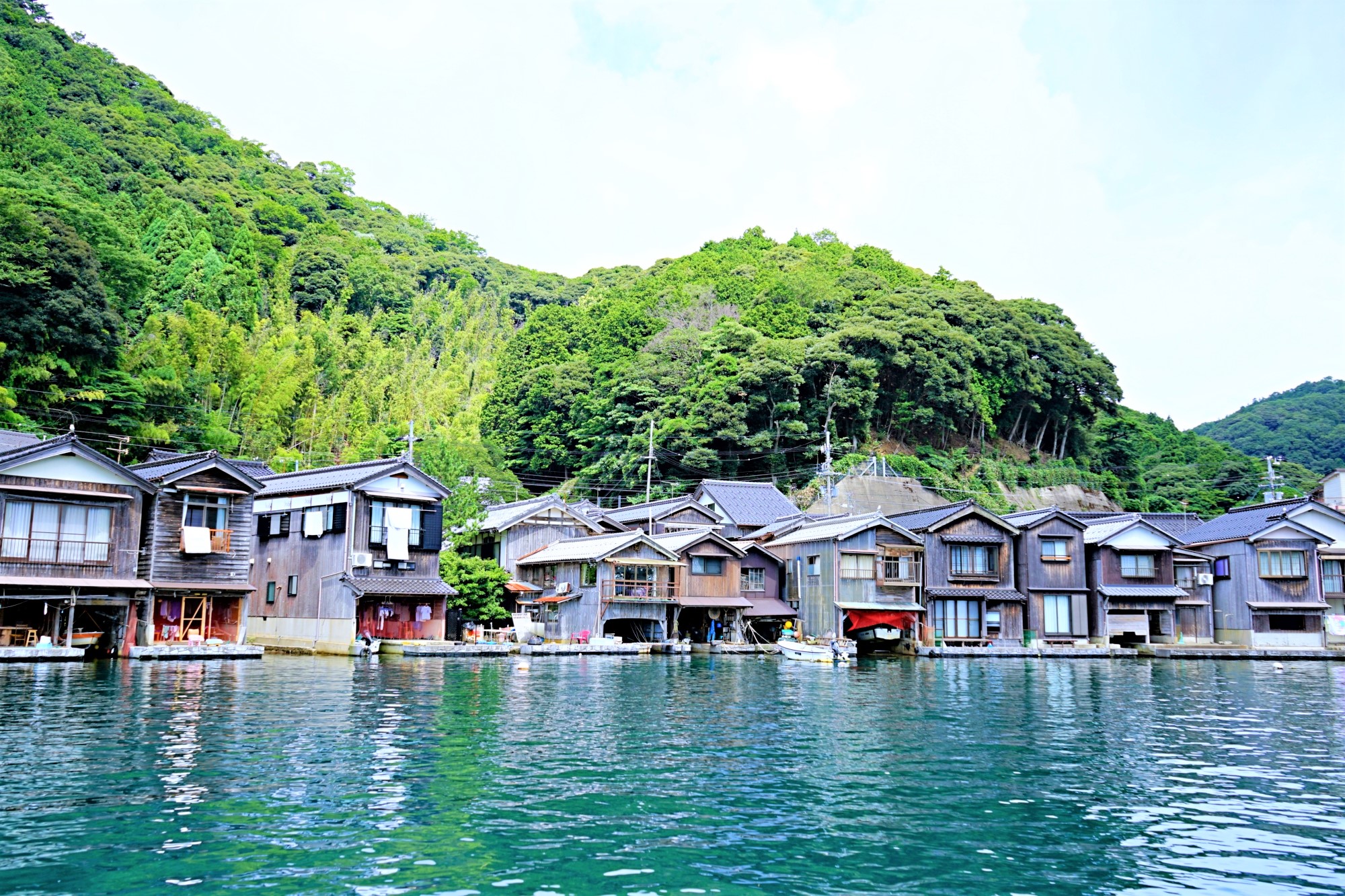Introduction to Ine no Funaya Architecture
Nestled in the serene Kyoto Prefecture lies a quaint fishing village that boasts a unique architectural marvel. Ine no Funaya, Japan’s “boat houses,” are unlike anything you’ve ever seen before. These intriguing structures showcase a harmonious blend of functionality and style. From their historical origin to their cultural significance, let’s dive into what makes the architecture of Ine no Funaya so special.
Historical background of Ine no Funaya
Ine no Funaya’s origins can be traced back over a millennium ago. These remarkable houses were first built during Japan’s Heian period (794-1185). Needless to say, these architectural marvels have stood the test of time. It’s no small feat that Ine no Funaya has survived countless natural disasters and the ever-changing landscape.
The ingenious design of these boat houses includes a two-story structure, where the first floor serves as a garage for the fishing boats, while the second floor serves as the living space. This practical design has proven to be the perfect solution to accommodate the fishermen’s lifestyle.
Cultural significance of Ine no Funaya
Ine no Funaya is more than just an architectural wonder – it’s a living, breathing testament to Japanese history and culture. These boat houses have been handed down through generations, and their continued existence is a reflection of the strong sense of community that exists among the residents of Ine.
To this day, preserved traditions and customs, such as the community-centered ‘gyonin-kai’ (fishermen’s association), can still be experienced in Ine. In the modern, fast-paced world we live in today, there’s something extraordinary about visiting a place where time seems to stand still.
Geographical location and features of Ine
Located in the Kyoto Prefecture, Ine is a picturesque fishing village that sits on the Tango Peninsula. What sets Ine apart is its distinct geographical features, creating an environment that is ripe for the existence of Ine no Funaya. The village is surrounded by a crescent-shaped bay, which provides natural protection from storms and other natural disasters. Coupled with the calm waters of the Sea of Japan, the physical aspects of Ine offer ideal conditions for such a unique architectural design.
Venture into the magical world of Ine no Funaya, and experience a piece of Japan that remains rooted in its historical past. Visitors also have the opportunity to stay in these remarkable boat houses, allowing them to fully immerse themselves in the unique culture of Ine. So, why not take a trip down memory lane and explore a world where architecture, history, and nature intersect?
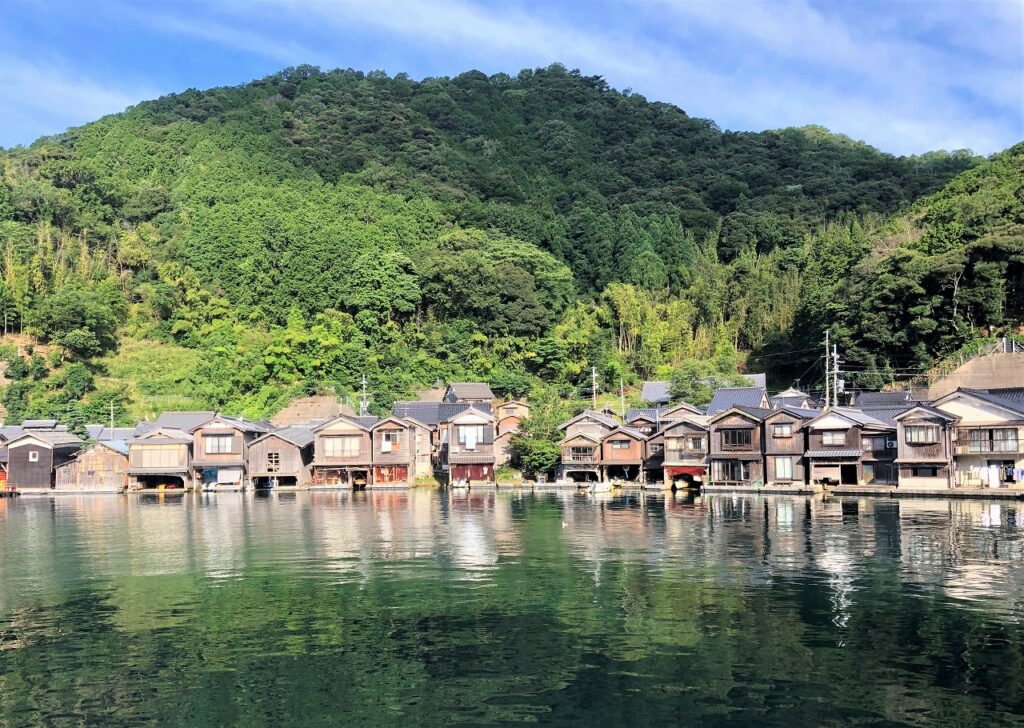
Characteristics of Ine no Funaya Architecture
Venturing down Japan’s scenic coastline, you’ll discover enchanting architectural marvels nestled in the beautiful bay of Ine. These boat houses, known as Ine no Funaya, boast a unique and functional design that’s been developed over centuries. So, let’s dive in and explore Ine no Funaya’s distinct characteristics, their architectural evolution, and the materials and techniques employed in these structures.
Distinctive Boat House Features
At first glance, Ine no Funaya may seem like quintessential Japanese waterfront cottages. However, a closer look reveals that they’re meticulously designed to accommodate both humans and their boats amidst the elements. A unique feature of these traditional boat dwellings is their two-story design. The first floor serves as a garage for boats and fishing equipment, while the upper floor is reserved for family living spaces. Moreover, these houses are harmoniously positioned on the water’s edge to ensure their occupants can launch boats right from their doorstep.
Another striking feature of Ine no Funaya is their profuse use of wooden decks. These balconies provide a practical and appealing outdoor space for residents, who can enjoy the scenic waterfront views. They also serve as a means for neighbors to interact, fostering a tight-knit community spirit.
Evolution of Funaya Architectural Style Over Time
Ine no Funaya has evolved over the centuries to adapt to the ever-changing environmental and socio-economic conditions. Before the 17th century, these boat houses were simple, single-story structures with thatched roofs. As the community became wealthier from their thriving fishing industry, they began erecting more sophisticated, two-story buildings.
A pivotal moment in Funaya architectural style came with the introduction of “kirizuma” style roofs. Characterized by their sharply sloping gables, kirizuma roofs proved to be highly functional in preventing the build-up of heavy snow in winter. Additionally, their steep angles harmonized with the surrounding mountainscape, enhancing the aesthetic appeal of these boat dwellings.
With the advent of the Edo period (1603 – 1868), Ine no Funaya architecture fully embraced the “machiya” style – a traditional urban merchant house with an elongated, narrow layout. This transformation allowed families to maximize their living space while preserving the practicality of boat storage.
Materials and Construction Techniques
Employing locally sourced construction materials has been instrumental in the development of Ine no Funaya. The sturdy wooden frames are primarily constructed from the region’s diverse array of timber, such as cedar, cypress, and pine. Thatched roofs made from reeds and rushes, traditionally used in Funaya’s early iterations, were replaced by wooden shingles and, eventually, modern corrugated metal sheets. These changes not only added durability to the structures but also simplified maintenance.
Interestingly, traditional construction techniques used in these buildings have been passed down through generations of local carpenters. The technique of “shima-dai,” for instance, involves using sturdy wooden pillars driven deep into the seabed to provide foundational support for the structures. This architectural innovation ensures the longevity of Ine no Funaya, even amidst the sometimes destructive forces of nature.
In conclusion, the Ine no Funaya represents a harmonious confluence of functionality, aesthetics, and tradition. These charming boat houses embody the adaptability of architecture in the face of evolving environmental, economic, and social conditions. Today, they not only stand as a testament to the ingenuity of their creators but also as a source of inspiration for architects from around the world.
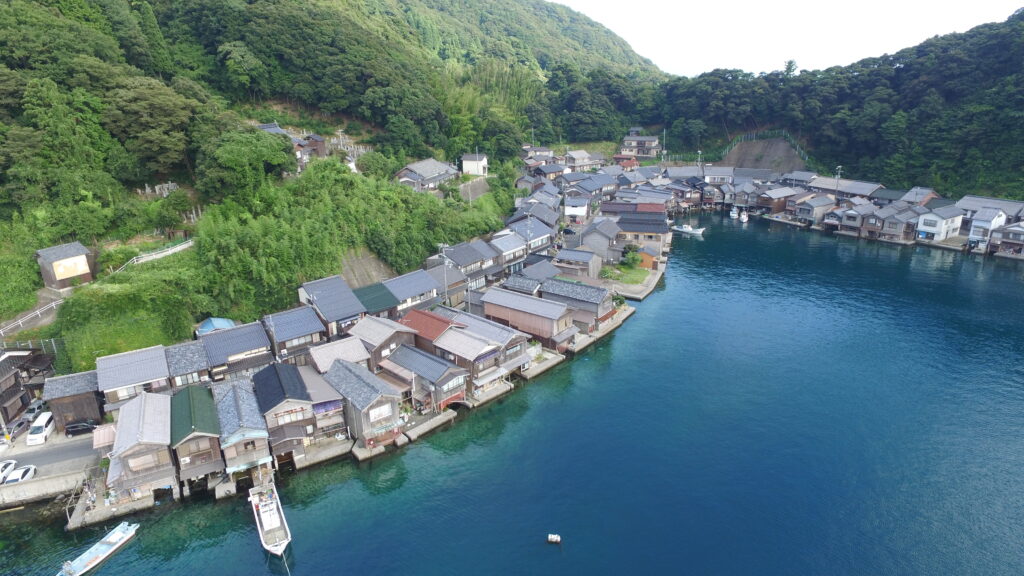
The Role of Funaya in Local Life
Fishing Culture and Professions
Ah, the quaint fishing village of Ine, nestled along the Sea of Japan in the Kyoto Prefecture. It’s brimming with picturesque beauty and a rich fishing culture that has been well-preserved for generations. And at the heart of it all are the “Funaya” houses, with their unique architecture and practical design. These distinctive fisherman’s homes serve a dual purpose, acting as both a residence and a boat slip. This multifunctional design showcases the practicality and ingenuity of the local fishermen, who have relied on these natural resources for centuries.
Ine’s fishing culture thrives thanks to the abundance of marine life in the area, including the delicious and sought-after yellowtail or “hamachi,” which plays a vital role in the prosperity of the local economy. Fishing traditions in Ine, such as “ama,” female divers who expertly gather abalone and other seafood without the aid of modern diving equipment, are passed down from generation to generation. Thus, Funaya houses bear witness to the strong connection between Ine’s fishermen and the sea, reflecting their way of life and playing a significant role in preserving their cherished customs.
Daily Life in a Funaya
So, what is life like living in one of these delightful Funaya houses? Imagine waking up to the soothing sounds of gentle waves lapping against the shore, as the sun casts its warm golden glow onto the water. Stepping into the first floor of your Funaya home, you’d find your trusty boat parked in the open living area, providing both shelter and security for your precious vessel, while preparing for the day’s fishing adventures.
Ascending to the upper floors of the Funaya building, you’d discover the residential area, complete with traditional tatami mat rooms, a kitchen, and living spaces. With large windows overlooking the bay, these homes not only afford views of the picturesque seascapes but also allow fresh sea air to permeate their cozy living quarters. It’s hard to shake the tranquil, idyllic atmosphere that these Funaya houses provide to those who call them home.
Preservation of Traditional Customs and Culture
With an ever-present eye on enhancing tourism, one might wonder if the village of Ine and its beloved Funaya architecture can maintain their unique character without succumbing to modernization or commercialization. Fear not, for the locals are deeply committed to preserving their cherished traditional way of life. In fact, Ine has been designated as a protected “Important Preservation District for Groups of Historic Buildings.” That’s a mouthful, but it essentially means that this charming village is given the attention and respect it deserves in maintaining its historical and cultural significance.
Ine’s residents take great pride in their unique heritage and work tirelessly to ensure that these architectural treasures endure. From organizing community-led restoration projects to hosting visitors for authentic homestay experiences, locals ensure that Ine continues to captivate the hearts of those who venture to this enchanting village.
With a strong emphasis on keeping their storied history alive, coupled with the striking beauty of its natural surroundings, Ine’s Funaya houses will surely stand as a testament to Japan’s vibrant, traditional way of life for generations to come. So why not take a journey off the beaten track and let the charm of Ine’s Funaya architecture and local culture captivate your senses? You won’t be disappointed!
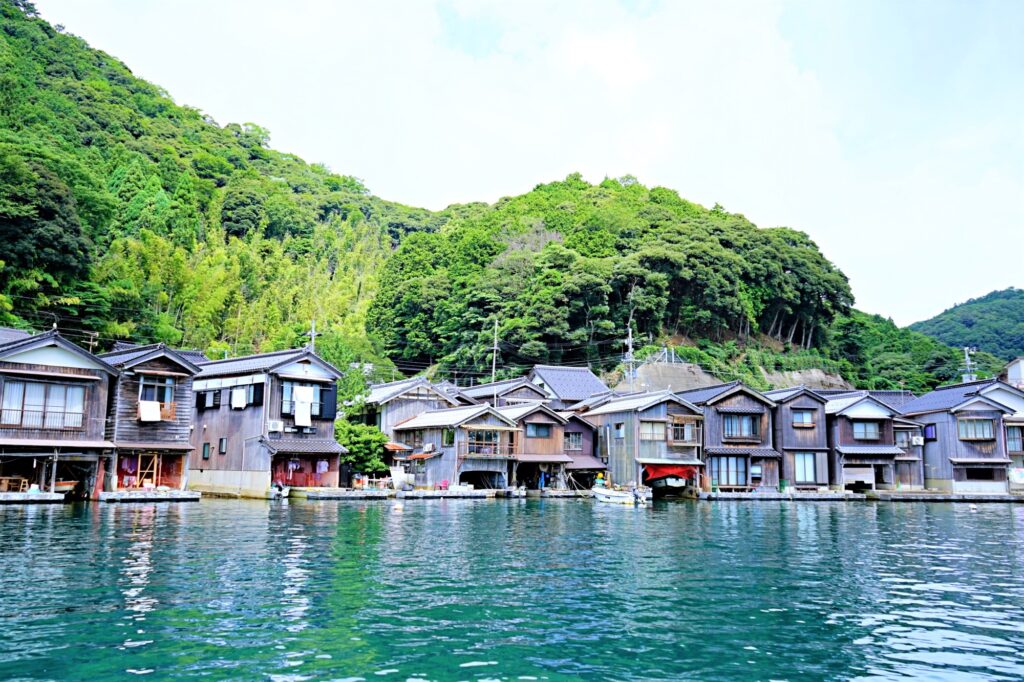
Exploring the Ine no Funaya Village
Nestled along the picturesque coastline of Kyoto Prefecture in Japan, the Ine no Funaya village is an architectural wonder that has stood the test of time. With its unique boathouses, called “funaya,” this quaint, historic fishing village has managed to preserve its traditional way of life while adapting to the modern world. Let’s embark on an adventure to uncover the secrets of this charming community!
Walking tour of Ine no Funaya
Resting on a gentle slope along Ine Bay, the funaya are a sight to behold, resembling a “Waterworld” movie set. These traditional wooden houses are two-storied structures, with the first floor serving as a boat garage and the second floor as a living space, characterized by thatched roofs, warm wooden walls, and traditional Japanese sliding doors.
A leisurely, self-guided walking tour of Ine no Funaya is recommended, as it allows you to stroll through the enchanting village lanes, admiring the picturesque funaya and catching glimpses of the daily life of local fishermen. Don’t forget to explore the many small pathways leading down to the waterfront for some postcard-perfect photo opportunities.
If you’d rather have someone show you around, guided walking tours are also available in English. These tours come with fascinating insights into the history and culture of the village, the intricacies of funaya architecture, and firsthand stories from longtime residents.
Significance of the Ine Bay
Ine Bay encompasses not only a stunning landscape but also an ecosystem that plays a pivotal role in supporting the village’s livelihood: the traditional art of fishing. Wild-caught fish like mackerel (“saba”) and tiger pufferfish (“fugu”) are aplenty in these waters, providing local fishermen with a steady source of income and contributing to the area’s reputation as a seafood paradise.
Additionally, the bay’s calm, sheltered waters make it an ideal location for the construction of funaya. With direct access to the sea from their homes, the fishermen can quickly set off in search of their daily catch and return home with ease, thus maximizing efficiency and convenience.
Hidden gems and scenic spots
While the funaya are undoubtedly the main attraction, the Ine no Funaya village also boasts a wealth of hidden gems and scenic spots that warrant exploration.
For starters, make your way to the Ine Shrine, tucked away in the forested hills overlooking the village. Here, you’ll encounter ancient stone steps and a serene atmosphere that makes you feel at one with nature. The shrine offers breathtaking views of the village, the bay, and the surrounding mountains, and is an exceptional place to immerse yourself in quiet contemplation.
That’s not all! Ine boasts an abundance of mouthwatering seafood, thanks to its fishing heritage. Sample the freshest sashimi at local restaurants or browse the seafood markets for the catch of the day. In the mood for something different? Keep an eye out for “mom-and-pop” eateries offering homecooked meals that’ll satiate your appetite.
Lastly, don’t miss out on the chance to stay at a local “minshuku” (guesthouse) or “ryokan” (traditional Japanese inn). Not only is it a fantastic opportunity to experience the warm hospitality of the locals, but you’ll also get to sleep in an authentic funaya and wake up to the mesmerizing view of the bay.
Adventure awaits in the Ine no Funaya village—tread its storied lanes, uncover hidden gems, and lose yourself in the beauty of this architectural marvel and the bounty of Ine Bay.
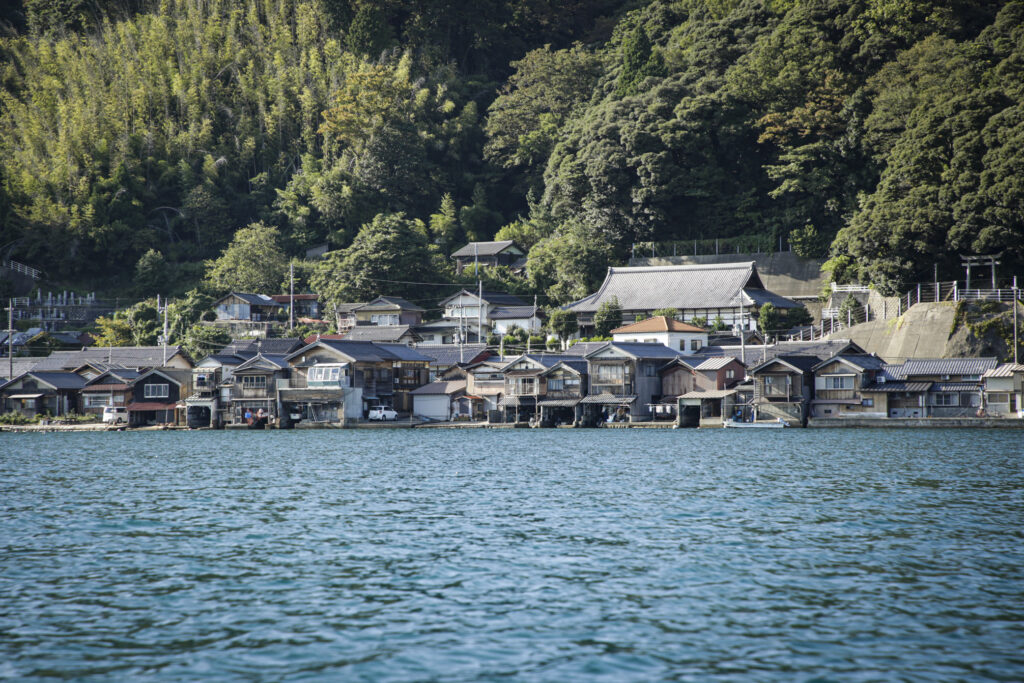
Visiting and Experiencing Ine no Funaya
Nestled along the coastline of Kyoto Prefecture, Ine no Funaya, or “the boathouses of Ine,” is a charming and picturesque village that offers a glimpse into Japan’s unique architectural traditions. The distinctive boathouses, which serve as both residences and storage spaces for fishing boats, are a testament to the adaptability of human ingenuity and the profound connection between people and their environment. Whether you’re a history buff or simply looking for a tranquil escape from the hustle and bustle of city life, Ine no Funaya is worth the journey.
How to Get to Ine
To experience the magic of Ine no Funaya firsthand, travelers can start their journey in either Kyoto or Osaka. Although it may appear off the beaten path, getting to Ine is surprisingly straightforward. From Kyoto, take the JR Kinosaki Limited Express train to Kyoto Tango Railway’s Miyazu Station, followed by a ride on the Tankai Bus bound for Kamanyu. Sit back, relax, and watch as the beautiful countryside scenery unfolds on this approximately two-and-a-half-hour trip.
Those setting off from Osaka should hop aboard the JR Limited Express Kounotori train, which will whisk them away to Kyoto Tango Railway’s Miyazu Station. Once there, simply follow the same route described above.
Best Time to Visit
While the enchanting boathouses of Ine no Funaya can be enjoyed anytime throughout the year, there’s something undeniably captivating about witnessing the village illuminated by the warm glow of the summer sun. Between June and August, the days are long, and the skies are crystal clear, offering breathtaking views of the Sea of Japan and the verdant mountain range that cradles the village.
Another excellent time to visit is during the autumn months of October and November when the landscape is awash with vivid hues of red, orange, and gold. This period also tends to see fewer tourists, so you’ll have more opportunities to soak in the tranquil beauty of Ine no Funaya in relative solitude.
Local Festivals and Events
A trip to Ine no Funaya wouldn’t be complete without immersing yourself in the local culture, and there’s no better way to do that than by joining in the village’s vibrant festivities. Each year, Ine hosts several events that showcase the region’s rich history, customs, and traditions, including the following:
-
Ine Funaya Festival (June): Celebrating the beginning of the marine season with traditional music and dance performances, the Ine Funaya Festival is the perfect opportunity to experience the village’s time-honored customs while connecting with the local community. Be sure to join the evening boat tour, where you can marvel at the illuminated boathouses from the water.
-
Ine Boat Race (August): Feel the adrenaline surge as you watch traditional fishing boats race through the calm waters of Ine Bay. This exciting event provides a glimpse into the extraordinary skill and teamwork required for these boats to navigate the high seas seamlessly.
-
Ine Hina Doll Festival (late February to early March): During this event, hundreds of Hina dolls are displayed in the town’s various venues, including locals’ homes, and pay homage to the unique Japanese art form. The festival is rooted in the belief that the dolls can bring good fortune and protect their owners from hardship.
As you explore the winding streets of Ine no Funaya, allow yourself to be transported back in time and immersed in the village’s enduring bond with the sea. A visit to Ine is a journey into the heart of Japan’s architectural heritage and a celebration of the enduring spirit that has allowed this captivating village to withstand the test of time and the elements.
Accommodation in Ine no Funaya
Unique guesthouses and ryokan
Nestled along the serene coastline of Kyoto Prefecture lies Ine no Funaya, a charming fishing village boasting an impressive architectural marvel: its boat houses, or funaya. Beyond merely admiring these fascinating structures from afar, visitors have the chance to immerse themselves in the local culture by staying in one of the area’s unique guesthouses and ryokan.
These accommodations, tastefully converted from authentic funaya or designed to echo their distinct style, provide a once-in-a-lifetime experience for travelers keen on embracing Ine’s rich fishing heritage. Picture it—a cozy room with a seaside view in a traditional Japanese guesthouse—can’t you just feel the relaxation setting in?
Staying at a traditional Funaya
By staying at a traditional funaya, guests can personally experience the architectural ingenuity in Ine no Funaya. True to their origins, these accommodations often feature rooms on the upper levels, with ample living space and tatami flooring, while the ground floor is dedicated to boat storage and maintenance. With direct access to the ocean, this unique combination of living space and boat garage provides both convenience and a fascinating glimpse into the daily lives of Ine’s fisherfolk.
As night falls, it’s hard not to appreciate the utter tranquility that envelops Ine no Funaya, punctuated only by the gentle lapping of waves against the shoreline.
Experiencing Ine’s hospitality
There’s something truly heartwarming about the genuine hospitality encountered in Ine no Funaya. Whether it be in traditional ryokan or funaya-turned-guesthouses, visitors can expect to be treated like family by their warm and welcoming hosts. No doubt this kindness stems from the strong sense of community in Ine, forged over generations of shared experiences along its rugged, picturesque coastline.
And what better way to cap off a day of exploring Ine’s natural beauty than indulging in the area’s culinary offerings? Many accommodation providers offer fresh, locally-sourced seafood as part of the Japanese-style breakfasts and dinners included in their stay. From mouthwatering sashimi to flavorful fish stews, these delicacies only serve to enhance a memorable stay in magical Ine no Funaya.
Ultimately, immersing oneself in Ine no Funaya’s charming accommodations truly unlocks the magic of this enchanting village. From the unique architecture of the funaya to the warmth of its people, a stay in Ine promises a revitalizing escape from the hustle and bustle of modern-day life.
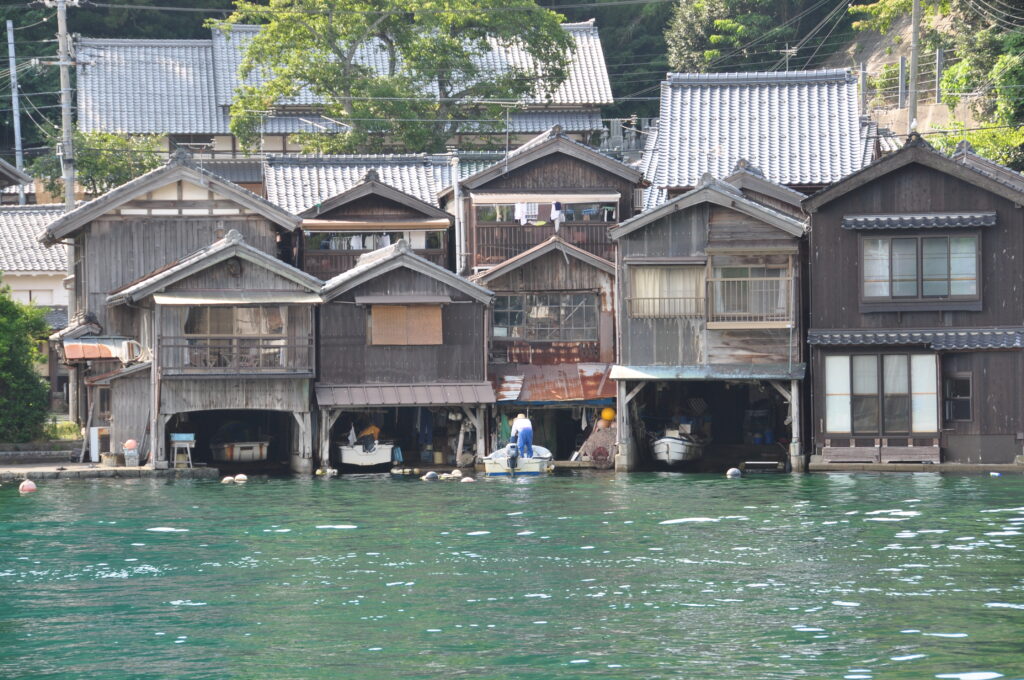
Sightseeing and Activities in Ine
Ine, located in the northern part of Kyoto Prefecture, is known for its captivating scenery and unique architecture manifested through the “Ine no Funaya,” or the “Boathouses of Ine.” These boathouses, which also serve as homes, showcase Japan’s traditional architectural skills and have been designated as a preservation district for groups of historic buildings. Visitors can immerse themselves in the wonderful world of Ine no Funaya through various activities such as boating, sea kayaking, and marine sports, as well as exploring nearby attractions.
Exploring by boat
It’s no wonder that the boathouses of Ine create a one-of-a-kind waterscape; they’re described as “houses that appear to float on the water.” One must not miss the chance to hop on a sightseeing boat to fully appreciate the beauty of these structures. A guided boat tour is an excellent way to explore the calm and serene Ine Bay, passing by rows of Ine no Funaya, as well as witnessing the livelihood of the locals who go about their daily routines. As the breeze gently kisses your face, you’ll be hard-pressed not to sit back and simply soak in the scenery.
Sea kayaking and marine sports
For the adventurous souls, Ine offers various marine sports such as sea kayaking, stand-up paddleboarding, and snorkeling. Sea kayaking provides an intimate and up-close experience with the Ine no Funaya, allowing visitors to paddle their way through the bay and navigate narrow canals passing by the boathouses. Moreover, the crystal-clear waters of the bay beckon marine enthusiasts to give snorkeling a try, as it unveils a whole new underwater world teeming with marine life. Not a fan of being in the water? No worries! You can still get those adrenaline kicks by trying out on-water activities like stand-up paddleboarding, a fun and innovative way to cruise the bay.
Visiting nearby attractions
While the Ine no Funaya are undoubtedly the crown jewel of the area, there’s more to Ine than meets the eye. After an enchanting day spent on the water, head east to the nearby town of Amanohashidate, where you can catch a glimpse of one of Japan’s three famed scenic views – a sandbar that stretches nearly 3.6 kilometers and is covered with over 8,000 pine trees. A visit to the region wouldn’t be complete without sampling the freshest seafood Ine has to offer. Spoil your taste buds at the local restaurants in town, savoring dishes like crab, tuna, and the famous funazushi – fermented fish with rice, served alongside a steaming cup of sake.
In the end, whether you’re an architecture aficionado, a thrill-seeker, or a nature lover, the harmonious blend of tradition and natural beauty in Ine no Funaya will undoubtedly leave an indelible memory on your heart and soul.
The Importance of Ine no Funaya for Local Economy
Nestled along the picturesque coastline of Kyoto, Ine no Funaya has become a vibrant epicenter for local economic growth. By marrying centuries-old traditions with modern sustainable practices, this seaside village offers a once-in-a-lifetime experience that attracts tourists and supports locals alike. Below, we’ll explore the myriad ways Ine no Funaya truly stands out as a beacon for thriving community development.
Tourism in Ine
When it comes to tourism, Ine no Funaya is no slouch. Often dubbed the “Venice of Japan,” this charming town draws in droves of curious travelers yearning to witness its unique architecture firsthand. With over 200 boathouses built right along the water’s edge – dating back as far as the 18th century – these traditional dwellings feature the perfect blend of form and function. Known as “funaya” in Japanese, these homes showcase not only living quarters on their top floors but also boathouses on their lower ones.
And it’s this very architectural marvel that captures the hearts and minds of visitors from near and far. As they meander through Ine no Funaya by boat, camera in hand, they’re offered an intimate glimpse into these captivating structures, treasuring the experience for years to come. Moreover, with some funaya offering homestays, tourists have the chance to fully immerse themselves in the local culture, fostering a genuine appreciation for these time-honored structures.
Promoting Sustainable Tourism
But it’s not just about offering stunning visuals; Ine no Funaya has placed a significant focus on sustainable tourism as well. In recent years, the town has made tremendous strides in preserving and promoting its cultural heritage without causing undue environmental strain. Through careful conservation efforts and eco-conscious initiatives, Ine no Funaya serves as a shining example of how to marry tourism with a clear focus on sustainability.
For example, guided tours emphasize eco-friendly practices, teaching visitors the importance of preserving the town’s natural beauty. Additionally, Ine no Funaya continually works on revitalizing its traditional culture through various workshops and events – all while promoting green tourism. In doing so, it ensures its prized architectural heritage and breathtaking natural surroundings aren’t compromised for generations to come.
Local Industries and Products
But that’s not all! Ine no Funaya isn’t just a haven for architecture enthusiasts; it’s also a flourishing hub for local industries and products. Primarily a fishing village, the town boasts a thriving seafood industry, offering a veritable treasure trove of fresh fish and shellfish to visitors and locals alike. As they stroll through the bustling local market, they’ll be delighted by the mouthwatering range of local cuisine, which often takes center stage during various food festivals held in the town.
And for those with a penchant for something, well, a little stronger, Ine no Funaya is home to several sake breweries that have been producing top-notch brews for centuries. With meticulous craftsmanship and a passion for tradition, these local artisans create products that taste as splendid as the town’s scenery looks.
So, just like its mesmerizing funaya houses, Ine no Funaya’s commitment to the local economy and sustainable tourism has ensured its place as one of Japan’s most cherished destinations. From camera-ready architecture to its sumptuous seafood and artisanal sake, it’s an experience that’s truly one for the record books!
Cultural Preservation and Future Trends
Efforts to preserve Funaya architecture
As time marches on, the residents of Ine have made conscious efforts to preserve the unique architecture of Ine no Funaya. They recognize the value of their cultural heritage, which has become a thriving tourist attraction. But it’s not all about tourism and profit; residents understand the responsibility to maintain these architectural masterpieces for future generations.
The local government has enacted strict building codes, ensuring that renovations and new construction adhere to traditional Funaya methodologies. This move safeguards the region’s signature look and keeps the authentic flair alive. Additionally, local artisans and craftsmen teach workshops to educate younger generations on traditional carpentry techniques and the art of maintaining these fascinating structures.
Modern adaptations of traditional Funaya
In a world where modernity often clashes with tradition, Ine no Funaya has managed to strike a perfect balance. Although its roots are firmly planted in centuries-old architectural styles, modern innovations have seamlessly woven their way into the fabric of Funaya life.
By incorporating modern facilities and amenities into the Funaya, residents have kept up with evolving lifestyle needs. For instance, some of these unique structures have been repurposed as cozy guesthouses, which allow visitors to experience the beauty of the Funaya lifestyle first-hand. They have also integrated contemporary elements, such as solar panels and heat insulation, into the design, ensuring that the Funaya is in tune with the times.
Future challenges for Ine no Funaya
While the preservation efforts and modernisation of Ine no Funaya have been largely successful, challenges loom on the horizon. One significant concern is climate change, given that Ine no Funaya is perched upon the shoreline. Rising sea levels threaten the very existence of these charming structures, making coastal protection measures a top priority for local authorities.
Besides, as younger generations migrate to urban areas, the ageing population of Ine may struggle to maintain these traditional structures. Encouraging the community’s youth to take part in the preservation of their hometown, either through education or by offering incentives, could help bridge this generational divide and ensure that Ine no Funaya is passed down through the ages.
In summary, the unique architecture of Ine no Funaya represents a delightful blend of cultural preservation and modern adaptation. In the face of various challenges, proactive efforts must continue to keep this living heritage alive for future generations to appreciate and enjoy.
Frequently Asked Questions about Ine no Funaya
What is the history behind Ine no Funaya?
Ine no Funaya is a picturesque fishing village located along the coast of the Sea of Japan. It’s been said that for the past 1,000 years or so, these quaint wooden homes, known as “funaya,” have been built in their unique style. One might wonder why these buildings are designed with a particular framework? Well, it’s believed that it was a result of the narrow land and limited arable soil available along the coastline back then. This led to the construction of these fascinating structures that you’re now dying to explore. Ingenious, isn’t it?
What makes Ine no Funaya architecture unique?
Funaya, which literally means “boat houses,” are not just your regular seaside homes. No siree! These architectural marvels have a multipurpose design, with the lower floor functioning as a garage for fishing boats and a workshop for the villagers. It’s astonishing to see that even with limited space, these houses were designed in such a way that the living quarters are on the second floor, with a wonderful view of the sea. So, you’ve got breath-taking architecture that doubles as a cozy dwelling. What more could you ask for?
How can I visit and experience Ine no Funaya?
Now you must be itching to see Ine no Funaya for yourself. Fear not, there are plenty of ways to experience the charm of this quaint village. One way to see the funaya up close is by taking a guided boat tour, which allows you to enjoy the scenic panorama from the water. Alternatively, you can simply meander down the narrow streets and gain an intimate understanding of Ine’s distinctive architectural beauty.
Is it possible to stay overnight in a traditional Funaya?
Absolutely! Nothing beats experiencing the authentic Japanese way of life than by staying in a traditional funaya. Many of these residences have been converted into guesthouses and provide a warm and intimate experience for visitors. Imagine waking up to the sound of gentle waves and the smell of the crisp sea air. It’s a dream come true for those seeking a one-of-a-kind cultural escape.
What are some popular sightseeing spots in Ine?
Once you’ve had your fill of exploring the funaya, Ine has a few more gems to offer. Marvel at the picturesque scenery from the Ine Bay Observatory Deck, or pay a visit to the serene Ine Shrine. If museums are more your cup of tea, head to the Ine Fisherman’s Culture Exchange Center and Ine Mizu no Yakata, which both showcase the village’s history and the importance of fishing to the local community.
How does Ine no Funaya contribute to the local economy?
Ine no Funaya has increasingly become a popular tourist destination over the years. Heavily dependent on fishing initially, the village has now diversified its economy by tapping into its rich cultural heritage. Tourists flock from afar to experience the charm of these timeless architectural treasures, adding a substantial boost to the local economy. What’s fantastic is that tourism helps support local artisans and fisheries, ensuring the village retains its charm and remains a picturesque slice of Japanese history. So, when you visit Ine no Funaya, you’re not only having an unforgettable experience, but you’re also playing a part in preserving the village’s heritage. It’s a win-win situation!
